What you need for quality heating! How to choose a circulation pump for heating a private house
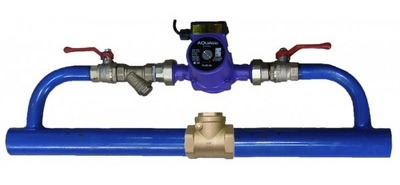
Circulation pump - a device that causes water to move through a piping system both in the forward and reverse directions.
Many types of heating systems require the installation of a circulation pump.
Content
Types of circulation pumps for heating, which are better
Circulation pumps for heating systems are divided into wet and dry.
Wet
The electric motor is separated from the water by sealing rings. The latter rotate during operation, touching each other. Between their surfaces there is a small layer of liquid., which serves as a sealant for connections. The latter is possible due to the difference in pressure in the atmosphere and the heating system. Despite the lack of direct contact of the rotor with water, the pump is called wet.
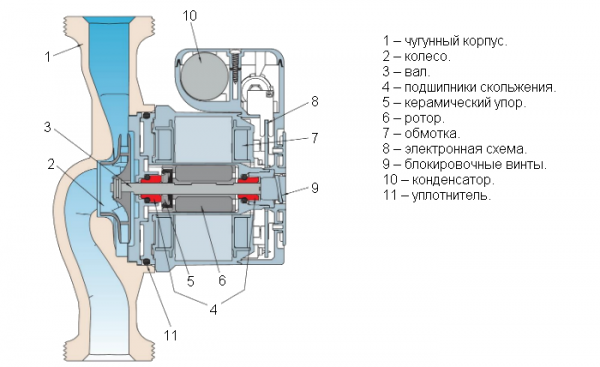
Photo 1. Schematic diagram of the wet-type circulation pump. The arrows indicate the parts of the device.
The main advantage is long service life. The sealed device can operate for up to three years without replacing the rings, despite their wear. This is true if no emergency situations occur.
The design eliminates engine lubrication and cooling from maintenance. Both functions are performed by the heat carrier, partially entering inside. For power supply, electric networks are used both on one and three phases, depending on the capacity of the installation. To facilitate installation, such pumps are equipped with special flange connections or standard threads. The type depends on the performance.
Wet type devices have the following advantages:

- silent operation;
- small size, low weight;
- low consumption of electrical energy;
- long service life without the need for maintenance;
- ease of setup and repair thanks to the modular design.
The main disadvantage of a wet circulation pump is its low efficiency. Efficiency rarely exceeds 50%. This is due to the impossibility of sealing the engine when its size increases. Therefore, such devices are used in small heating systems, for example, in private houses.
Attention! It is necessary to contact to specialists for installation. This will ensure uninterrupted operation, during which the coolant will flow to the bearings, lubricating them.
Dry
Due to the design, the rotor does not interact with the coolant. The pumps have a large, in comparison with wet, efficiency factor of about 80%. But there is two important disadvantages:
- High noise during operationThe problem is solved by installing sound insulation in the room with the pump.
- The need to frequently change water and air filters. A dry device requires cleaning the environment, since during operation, swirls arise that attract dust. The latter can lead to breakage, damage to the seal. Control of dustiness will increase the duration of operation of the device.
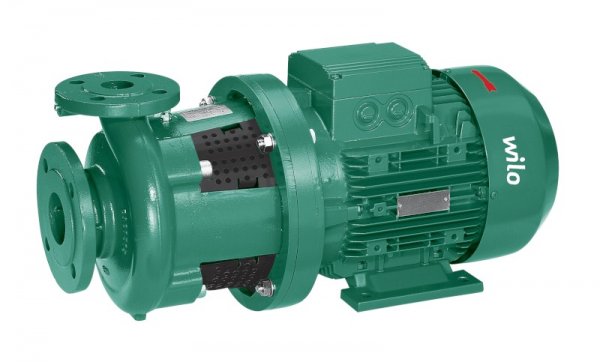
Photo 2. Dry-type circulation pump from the manufacturer Wilo. Such devices are much larger than products with a wet rotor.
Dry type circulation pumps divided into 3 types:
- horizontal, in which, as the name suggests, the engine is located parallel to the ground, and the pipes are at the end;
- vertical, with a motor installed perpendicular to the floor and pipes in one axis;
- block, in the form of cabinets that are mounted in the wall.
How to choose the best pump for a private home heating system
Depends on the type of system and the required functions, calculations carried out when creating the project.
General parameters
Recommended pay attention to 4 characteristics:
- Permissible temperature. High-quality devices support operation in the range 110—130 °C. It should be taken into account that even an inexpensive device should have in the description not less than 90 °C. This does not apply to low-temperature systems. On the contrary, for solid fuel boilers, this indicator is very important.
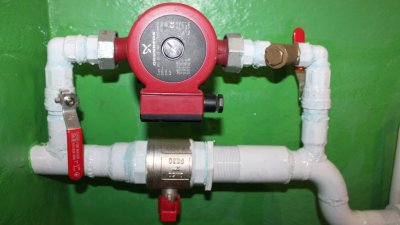
- The material used in the manufacture of the body. The most favorable in terms of price-quality ratio is considered to be cast iron. If you are short on budget, it is recommended to look for a pump from heat-resistant plastic.
- Connection size: from G1 to G4. And the type is also important: threaded or flanged. Threaded It is divided into external and internal, and special adapters must be installed for them. Flanged — a one-piece mount, for the selection of which it is sufficient to take into account the diameter of the mounting point.
- Two types of protection are required: dry running and overheating.Both types are used in circulation pumps to extend service life. First It is used in “wet” devices for safe cooling of the motor. Second is designed to turn off the device when the critical temperature is reached. High-quality protection will ensure safety and avoid accidents.
Selection based on performance
The power of the device must be sufficient to transfer the hot coolant to all sections of the piping. A simple formula is used for calculation:
K = N, where N is the boiler power in kW.
Dimension K — liters per minute. So, for the heater 30 kW use a pump 30 l/min.
Pressure in one-story and two-story houses

Each device has an upper limit, crossing which threatens the occurrence of malfunctions. In private two-story houses it is accepted for 3-4 atmospheres, in other cases - for 1.5-2.5.
It is necessary to calculate the height of the water rise by the device. For this determine the length of the harness and multiply it by 0.06 m. For example, for 80 m pipes need pressure 4.8 atm.
It is advisable to choose a pump with several speeds.This will allow you to control consumption or heat the room faster, if necessary.
Important! It is recommended to select devices up to 1.6 m/s, because otherwise noise occurs.
External conditions
The diameter of the pipes must correspond to the calculations for the piping.. The number is found when creating the project. Using smaller materials will reduce the pressure in the system. This rule also works in the opposite direction.
It is possible to use a bypass, which will create a natural circulation of the coolant. For installation you will need to purchase pipes of a smaller diameterThey are placed around the pump, cutting the tap into any area.
How to choose a device based on consumption characteristics
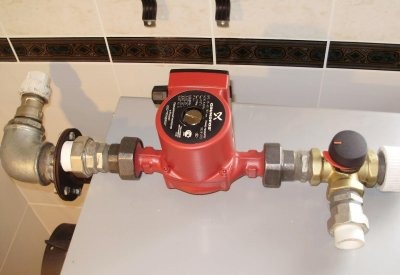
0.1 kW/m2 for small private houses;Depends on the size of the building and the region in which it is located. In warm climates it is necessary:
- 0.07 kW/m2 for multi-apartment buildings;
- <0.05 kW/m2 for industrial buildings.
In cold regions, the following standards are used SNiP 2.04.07-86, according to which:
- For low-rise buildings, pumps with a capacity of 173-177 W/sq. m.
- For 3-storey and higher ones - 97-101 W/sq. m.
Useful video
Watch the video to learn how to properly install a circulation pump in a heating system.
Conclusion
A properly selected circulation pump will increase the comfort of heating operation. The main thing is to carefully select the device and connect it according to the rulesFor recommendations and installation, you should invite heating and electrical specialists.








